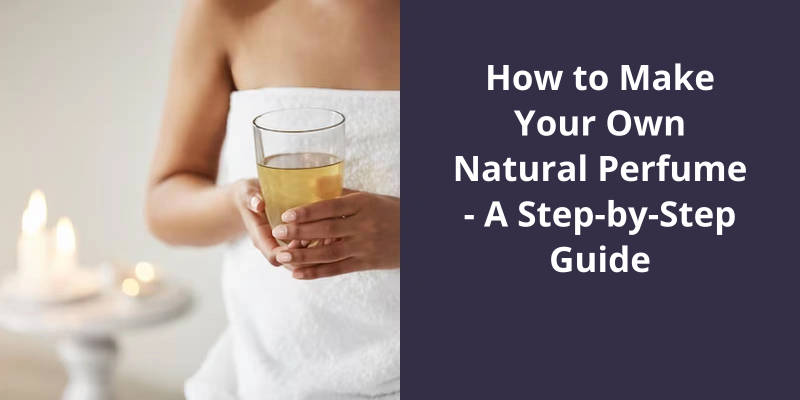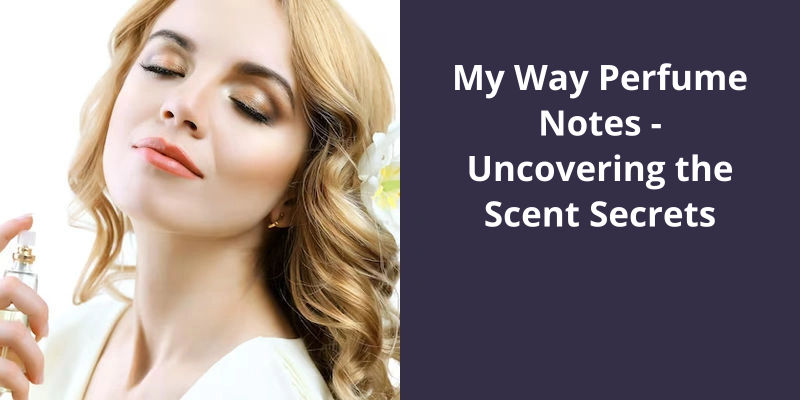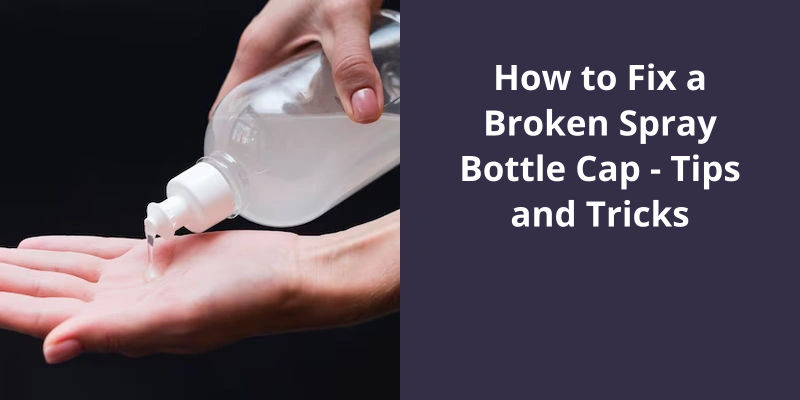Creating your own natural perfume is a creative and fulfilling way to express your personal style and indulge in the luxurious world of fragrances. Instead of relying on mass-produced synthetic fragrances, why not embark on a journey of self-discovery and concoct a unique perfume that perfectly captures your essence? With just a few simple ingredients and a step-by-step guide, you can create a signature scent that’s both alluring and free from harmful chemicals. To start, gather the following ingredients and tools: 2 tablespoons of carrier oil such as sweet almond, coconut, or jojoba, 6 tablespoons of 100-proof alcohol, 2.5 tablespoons of bottled water, 30 drops of essential oils (divided into 9 drops of top notes, 15 drops of middle notes, and 6 drops of base notes), a coffee filter, a small funnel, and two clean dark-glass bottles with airtight lids. Now, let's dive into the exciting process of making your own natural perfume, step-by-step.

Can You Make Natural Perfume?
These oils are typically derived through a process called steam distillation, where steam is used to separate the volatile compounds from the plant material. The result is a concentrated oil that captures the unique scent and therapeutic benefits of the plant.
To make your own natural perfume, youll want to start by choosing your essential oils. There are a wide variety of oils to choose from, each with it’s own distinct aroma and properties. Some popular choices for perfume making include lavender, rose, jasmine, bergamot, and sandalwood.
Once youve chosen your oils, it’s time to create your perfume blend. Start by combining your base notes, which are typically the heavier, longer-lasting scents. These can include oils like sandalwood or patchouli. Next, add in your middle notes, which provide balance and harmony to the blend. Some examples of middle notes include lavender or geranium. Finally, add in your top notes, which are the lighter, more volatile scents that are often the first to be noticed. These can include oils like bergamot or grapefruit.
It’s important to start with a small amount and adjust as needed to find the right balance of scents. Once youre happy with your blend, let it sit for a few days to allow the scents to meld together.
When youre ready to use your perfume, simply dab a small amount onto your pulse points, such as your wrists, neck, or behind your ears. The heat from your body will help to release the fragrance and allow it to evolve throughout the day.
Making your own natural perfume isn’t only a fun and creative way to express your individuality, but it also allows you to avoid the synthetic ingredients found in many commercial perfumes. By using essential oils, you can create a personalized scent that reflects your unique style and preferences. So why not give it a try and start crafting your own signature fragrance today?
Tips for Choosing the Right Essential Oils for Your Natural Perfume Blend
When creating your own natural perfume blend, it’s important to choose the right essential oils that complement each other and create a harmonious scent. Here are some tips to help you make the right choices:
1. Start with a base note oil: These oils have a strong and long-lasting aroma. Some popular base note oils include sandalwood, patchouli, and vanilla.
2. Add middle note oils: These oils create the body of your perfume and help balance the base and top notes. Examples of middle note oils are lavender, rosemary, and ylang-ylang.
3. Include top note oils: These oils provide the initial burst of scent and tend to evaporate quickly. Common top note oils include citrus oils like bergamot, lemon, and grapefruit.
4. Consider the scent profile: Think about the overall scent you want to achieve. Do you prefer a floral, woody, or citrusy fragrance? Choose oils that fit your desired scent profile.
5. Experiment and blend: Don’t be afraid to mix different oils together to create a unique scent. Start with a small amount of each oil and gradually add more until you achieve the desired fragrance.
Remember, creating your own natural perfume is a personal and creative process, so have fun and feel free to experiment with different essential oils until you find the perfect blend for you.
Making perfume with just water and flowers is a simple and natural way to create your own signature scent. By using cheesecloth and a pot, you can extract the scented essence from the flowers and transfer it into a bottle for easy application. With this homemade perfume, you can embrace the beauty of nature and enjoy the delicate fragrance of your favorite flowers.
Can You Make Perfume With Just Water and Flowers?
Making your own natural perfume can be a fun and rewarding experience. While there are numerous methods to create unique scents, one simple approach involves using just water and flowers. Yes, it’s indeed possible to make perfume with only these two ingredients.
To begin, gather a bouquet of your preferred fragrant flowers. Roses, lavender, jasmine, or any other blossoms that appeal to your olfactory senses will work. Placing the flowers in a bowl, cover them completely with water. Allow the flowers to steep in the water for several hours or overnight, ensuring that the essence of the flowers is infused in the liquid.
Once the steeping process is complete, use the edges of a cheesecloth to carefully remove the flowers from the bowl. The cheesecloth acts as a filter, straining out any solid particles and leaving behind a clear, scented liquid. Slowly pour this water into a pot, being cautious not to spill any precious drops.
Next, gently squeeze the cheesecloth-bundled flowers to extract the remaining scented water. This step retrieves any remaining fragrance that’s trapped within the petals. Every drop of this precious liquid counts, so ensure that you thoroughly extract as much as possible.
Finally, it’s time to transfer your homemade perfume into a small bottle. Select a container that’s airtight and preferably dark in color, as this helps preserve the fragrance for a longer period. Carefully pour the scented water into the bottle, ensuring that you don’t waste any of your hard work. Cap the bottle tightly to seal in the aroma, and store it in a cool, dry place away from direct sunlight.
Congratulations! Now, enjoy the delightful fragrance that’s uniquely yours. Spray it lightly on your wrists, behind your ears, or apply it wherever you like to experience a personal touch of natures beauty. As you bask in the wonderful aroma, take pride in the fact that you’ve made a sustainable, chemical-free perfume that’s as gentle on your skin as it’s on the environment.
Different Methods of Making Natural Perfume Using Flowers and Water
- Steam distillation method
- Cold-press extraction method
- Enfleurage method
- Maceration method
- Tincture method
- Solvent extraction method
- Infusion method
Source: How to Make Perfume (Flower Blossoms and Water Method)
Moving on to Step 4, after mashing the petals and adding distilled water, it’s time to strain the mixture and add essential oils. This will help enhance and balance the floral fragrance of the perfume. Stay tuned to discover the final steps of creating your own organic perfume using flowers!
How Do You Make Organic Perfume From Flowers?
Making your own natural perfume from flowers is a rewarding and aromatic experience. It allows you to create a unique scent that’s free from synthetic chemicals and full of the essence of nature.
Step 1: Find your flowers. Before you start, you need to decide what scent youre going for. Creative possibilities are endless, from roses to lavender, jasmine to lilac. Choose flowers that are fresh and fragrant, as these will yield the best results.
Step 2: Soak petals in vodka. Once you’ve gathered your preferred flowers, place the flower petals in a glass jar and cover them with vodka. Vodka acts as a solvent, extracting the beautiful fragrance oils from the petals. Ensure that the petals are fully submerged in the vodka to allow for complete extraction.
Step 3: Mash and let sit. Using a spoon or a muddler, gently mash the petals to release the aromatic oils. This step helps to enhance the scent and flavor of the petals. After mashing, let the mixture sit for at least two days, allowing the vodka to absorb all the delightful floral essences.
Step 4: Strain and add essential oils. Once the mixture has had enough time to infuse, strain the liquid into a clean container, removing the flower petals. This step removes any unwanted debris and ensures a smooth, clear perfume. To enhance the fragrance further, you can now add a few drops of your favorite essential oils. This will provide depth and complexity to your homemade perfume.
Experiment with different flower combinations and essential oils to unleash your creativity and capture the essence of nature in a bottle. Enjoy the journey of creating your own signature scent that isn’t only beautiful but also free of harmful chemicals.
How to Make Your Own Perfume Packaging and Branding for Your Homemade Scents
- Gather inspiration for your perfume packaging and branding.
- Decide on the overall look and feel you want for your homemade scents.
- Choose a color scheme that aligns with your fragrance and target audience.
- Design a logo or label that represents your brand and complements your packaging.
- Select the type of packaging you want, such as bottles, jars, or sprays.
- Consider eco-friendly options and sustainable materials for your packaging.
- Create custom labels or tags with information about your scents and ingredients.
- Personalize your packaging with your logo, label, or unique branding elements.
- Explore different printing methods or techniques for your labels and packaging.
- Add finishing touches like ribbons, stickers, or seals to enhance the overall presentation.
- Ensure your packaging is secure and protects the integrity of your homemade scents.
- Consider packaging options that allow customers to sample or test your fragrances.
- Include any necessary legal information, such as ingredient disclosures or warnings.
- Experiment with different packaging layouts and configurations to find the best fit.
- Showcase your unique branding and packaging on your website or online store.
- Regularly evaluate and update your perfume packaging and branding to stay relevant.
When it comes to choosing between fragrance and natural fragrance, it’s important to understand the differences and considerations. Natural fragrances are extracted from essential oils and plant extracts, making them a popular choice for those seeking a safer and gentler option for their skin. However, it’s crucial to note that natural fragrances can be pricier and may still trigger allergic reactions in certain individuals. Hence, it’s essential to weigh the pros and cons based on personal preferences and sensitivities.
What Is the Difference Between Fragrance and Natural Fragrance?
Natural fragrance refers to fragrances that are derived from natural sources, such as essential oils and plant extracts. These fragrances are typically made from the aromatic compounds found in these natural substances, which give them their unique scents. In contrast, synthetic fragrances are created in laboratories using chemical compounds to mimic specific scents found in nature.
One of the main differences between natural fragrances and synthetic fragrances is their safety profile. This is because they’re derived from natural sources and don’t contain chemicals that may irritate or sensitizing the skin. Synthetic fragrances, on the other hand, may contain chemicals that can potentially cause skin irritation and allergic reactions.
Another difference between natural and synthetic fragrances is their cost.
It’s worth noting that while natural fragrances are generally considered to be safer, they can still cause allergic reactions in some individuals. This is because natural fragrances contain complex mixtures of many different chemical compounds, and some people may be sensitive to certain compounds found in these fragrances. It’s always recommended to do a patch test before using any new fragrance to check for any potential skin reactions.
When it comes to making your own natural perfume, there are several methods you can use. One popular method is to blend essential oils together to create your desired scent. You can experiment with different combinations of oils to create a fragrance that’s uniquely yours. Another method is to infuse oils with dried flowers or herbs to create a more complex and layered fragrance. You can also use carrier oils such as jojoba oil or coconut oil to dilute your essential oils and help them last longer on the skin.
It allows you to customize your scent and avoid the potentially harmful chemicals found in many synthetic fragrances. Whether you prefer floral, woody, or citrus scents, there are plenty of options to choose from when creating your own natural perfume. Just remember to patch test your creations and be cautious of any potential allergies or sensitivities.
The Benefits of Using Natural Fragrances in Skincare Products
- Natural fragrances in skincare products are derived from plants and botanical sources.
- They’re free from synthetic chemicals and artificial ingredients that may irritate the skin.
- Natural fragrances have therapeutic properties that can uplift mood and promote relaxation.
- They don’t contain phthalates, which are potentially harmful chemicals commonly found in synthetic fragrances.
- Using natural fragrances can reduce the risk of skin allergies and sensitivities.
- These fragrances often have natural antibacterial and antimicrobial properties, helping to keep the skin healthy and clean.
- Natural fragrances are environmentally friendly as they’re derived from sustainable and renewable resources.
- They may provide additional benefits such as antioxidant protection and hydration to the skin.
- Using products with natural fragrances can create a more holistic and spa-like experience.
Creating your own non-toxic fragrance is a fun and sustainable way to enjoy a personalized scent. With just a few natural ingredients, you can concoct a fragrance that’s both free from harmful chemicals and uniquely suited to your preferences. The key components include jojoba oil, vodka, distilled water, and essential oils, which combine to create a beautiful and long-lasting scent. Let’s explore how to make this non-toxic fragrance step by step.
How Do You Make Non Toxic Fragrance?
Making your own non-toxic fragrance can be a fun and rewarding project. By using natural ingredients, you can create a scent that isn’t only safe for you, but also for the environment. One key ingredient for making non-toxic fragrances is jojoba oil. Jojoba oil is a great carrier oil because it doesn’t have a strong odor of it’s own and blends well with essential oils.
To start making your natural perfume, you’ll need 3 teaspoons of jojoba oil or another carrier oil such as sweet almond oil. This will be the base of your perfume and will help to dilute the essential oils. Next, add 2 tablespoons of vodka to the carrier oil. The higher the quality of the vodka, the less odor it will have and the more it will help to preserve your fragrance.
Distilled water is important because it doesn’t contain any impurities that could affect the scent of your perfume. Finally, you’ll need around 70 drops of essential oils to create the desired fragrance. Essential oils come in many different scents, so you can choose the ones that you enjoy the most and experiment with different combinations.
When choosing essential oils, it’s important to note that some can be irritating to the skin in high concentrations. It’s best to start with a small number of drops and add more if needed. Once you’ve gathered all of your ingredients, you can mix them together in a small glass bottle or rollerball container. Shake the mixture well to ensure that all of the ingredients are fully combined.
To use your non-toxic fragrance, simply apply a small amount to pulse points, such as your wrists and neck. The fragrance will gradually release throughout the day, creating a beautiful and natural scent. Remember that natural perfumes may not last as long as synthetic ones, so you may need to reapply throughout the day.
Experiment with different essential oil combinations and have fun creating a fragrance that’s uniquely you.
Conclusion
Remember, the recipe for a perfect perfume lies in finding the right balance between carrier oils, alcohol, water, and essential oils. With the help of a coffee filter and funnel, you can effortlessly strain and transfer your creation into the dark-glass bottles, ensuring it’s longevity and potency. So why settle for commercial perfumes when you can embark on an exciting adventure of crafting your own signature scent, tailored to your unique style and personality!





